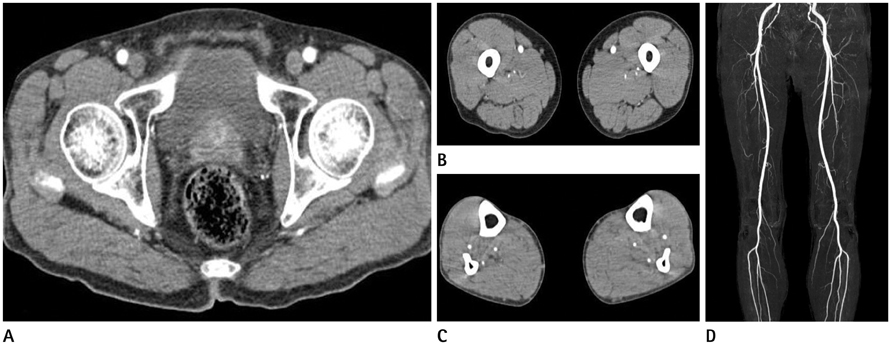J Korean Soc Radiol.
2014 Sep;71(3):120-127. 10.3348/jksr.2014.71.3.120.
Biliary Stent Placement for the Management of Acute Obstructive Jaundice after Uncovered Gastroduodenal Stent Placement
- Affiliations
-
- 1Department of Radiology, Kyung Hee University Medical Center, College of Medicine, Kyung Hee University, Seoul, Korea. kwon98@khu.ac.kr
- 2Department of Radiology, Korea University Guro Hospital, Korea University College of Medicine, Seoul, Korea.
- KMID: 1736476
- DOI: http://doi.org/10.3348/jksr.2014.71.3.120
Abstract
- Acute biliary obstruction after placement of an uncovered gastroduodenal stent is an uncommon complication. In the present report, we introduce two cases of acute obstructive jaundice after uncovered pyloric and duodenal stent placement. Treatment by placement of a biliary stent was successful in both cases.
MeSH Terms
Figure
Reference
-
1. Hankey GJ, Norman PE, Eikelboom JW. Medical treatment of peripheral arterial disease. JAMA. 2006; 295:547–553.2. Cernic S, Pozzi Mucelli F, Pellegrin A, Pizzolato R, Cova MA. Comparison between 64-row CT angiography and digital subtraction angiography in the study of lower extremities: personal experience. Radiol Med. 2009; 114:1115–1129.3. Ofer A, Nitecki SS, Linn S, Epelman M, Fischer D, Karram T, et al. Multidetector CT angiography of peripheral vascular disease: a prospective comparison with intraarterial digital subtraction angiography. AJR Am J Roentgenol. 2003; 180:719–724.4. Met R, Bipat S, Legemate DA, Reekers JA, Koelemay MJ. Diagnostic performance of computed tomography angiography in peripheral arterial disease: a systematic review and meta-analysis. JAMA. 2009; 301:415–424.5. Utsunomiya D, Oda S, Funama Y, Awai K, Nakaura T, Yanaga Y, et al. Comparison of standard- and low-tube voltage MDCT angiography in patients with peripheral arterial disease. Eur Radiol. 2010; 20:2758–2765.6. Apfaltrer P, Hanna EL, Schoepf UJ, Spears JR, Schoenberg SO, Fink C, et al. Radiation dose and image quality at high-pitch CT angiography of the aorta: intraindividual and interindividual comparisons with conventional CT angiography. AJR Am J Roentgenol. 2012; 199:1402–1409.7. Menzel H, Schibilla H, Teunen D. European guidelines on quality criteria for computed tomography. Publication no. EUR 16262 EN. Luxembourg: European Commission;2000.8. Verdun FR, Bochud F, Gundinchet F, Aroua A, Schnyder P, Meuli R. Quality initiatives* radiation risk: what you should know to tell your patient. Radiographics. 2008; 28:1807–1816.9. Schillinger M, Exner M, Mlekusch W, Rumpold H, Ahmadi R, Sabeti S, et al. Vascular inflammation and percutaneous transluminal angioplasty of the femoropopliteal artery: association with restenosis. Radiology. 2002; 225:21–26.10. Kubo T, Lin PJ, Stiller W, Takahashi M, Kauczor HU, Ohno Y, et al. Radiation dose reduction in chest CT: a review. AJR Am J Roentgenol. 2008; 190:335–343.11. Somatom, Workflow Assistant-Definition syngo 2009A-2009. Siemens AG.12. Foster BR, Anderson SW, Uyeda JW, Brooks JG, Soto JA. Integration of 64-detector lower extremity CT angiography into whole-body trauma imaging: feasibility and early experience. Radiology. 2011; 261:787–795.
- Full Text Links
- Actions
-
Cited
- CITED
-
- Close
- Share
- Similar articles
-
- Benign biliary stricture caused by transduodenal lumen-apposing metal stent placement for pancreatic acute necrotic collection
- Management of Occluded Biliary Uncovered Metal Stents: Covered Self Expandable Metallic Stent vs. Uncovered Self Expandable Metallic Stent
- Endoscopic Stent Placement in the Palliation of Malignant Biliary Obstruction
- Percutaneous placement of self-expandable metallic stents in patients with obstructive jaundice due to hepatocellular carcinoma
- Coincidental Occurrence of Acute In-stent Thrombosis and Iatrogenic Vessel Perforation During a Wingspan Stent Placement: Management with a Stent In-stent Technique



